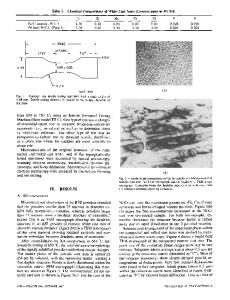Characterization and corrosion behavior of high-chromium white cast irons
- PDF / 671,075 Bytes
- 9 Pages / 612 x 792 pts (letter) Page_size
- 11 Downloads / 323 Views
-CHROMIUM white cast irons (CWIs) can be divided into three main alloy types according to their key elements (e.g., Fe, Cr, C), which determine whether they are hypoeutectic, eutectic, or hypereutectic alloys.[1–4] As the genuine Fe3C carbide in the Fe-C system can accept partial substitution of Fe by Cr in the Fe-Cr-C system, hypoeutectic alloys are formed in the Fe-Cr-C system at Cr/C ratios ranging from 15 to higher ratios with low chromium and carbon contents, while hypereutectic alloys are formed at Cr/C ratios lower than 15. Hypoeutectic alloys indicate that solidification of CWI is initiated by the formation of austenite (g) as a primary phase, and the eutectic phase is formed later. In hypereutectic alloys, M7C3 acts as a main phase since it is the phase formed primarily and is followed by the solidification of the eutectic phase with a eutectic structure (M7C3 1 g). Erosion-resistant CWIs have been used in the mining industry because of their ultrahigh hardness.[5,6] Management of corrosion to an acceptable level is a major issue in materials selection and in aggressive environments (i.e., in slurry pipes/pumps), it is often necessary for materials to resist both corrosion and erosion. For CWIs, it is documented that it is necessary to have at least 12 wt pct Cr in the matrix for ambient temperature service from a corrosion point of view.[1] This amount of chromium will form a sufficiently protective chromium oxide (Cr2O3) on the surface to protect the materials from its environment.[2] Watson et al.[7] reported that the binderless-carbide materials offered the best corrosion resistance, while a commercial CWI sample suffered the highest corrosion rate in a 1 N A. NEVILLE, Professor of Tribology and Surface Engineering, and F. REZA, Materials Engineer, are with the Corrosion and Surface Engineering Research Group, School of Mechanical Engineering, University of Leeds, Leeds, U.K., LS2 9JT. Contact e-mail: [email protected] S. CHIOVELLI, Director of Research, and T. REVEGA, Senior Materials Technologist, are with Syncrude Canada Ltd., 9421-17 Avenue, Edmonton, Alberta, Canada, T6N 1H4. Manuscript submitted August 5, 2005. METALLURGICAL AND MATERIALS TRANSACTIONS A
Na2SO4 solution (pH 6.8). This was due to the microgalvanic coupling between the carbides and the matrix. It was found that the matrix acted as a sacrificial anode, since the corrosion potential of the carbides was believed to be more noble than that of the matrix.[1,7] The depleted zone around the carbide was thought to be responsible for the main corrosion attack on the CWI alloy. Zumelzu et al.[8] studied the role of chromium and nickel on the corrosion behavior of CWI alloys in sugar media and reported that the combination of high Cr/C ratio (larger than 27) and Ni/C ratio (1.8 to 6.2) gave the best corrosion resistance for CWI alloys. Adding other beneficial elements such as nickel in CWI alloys acts to stabilize austenite in the matrix. Due to minimal alloying of carbides, nickel can reduce the precipitation of carbide-forming elements.[7,9] F
Data Loading...










